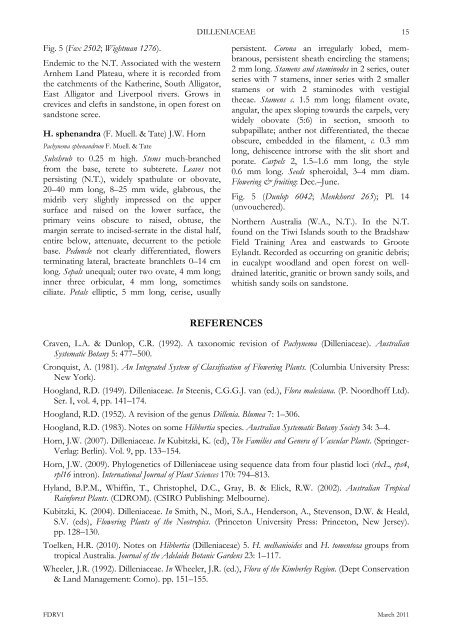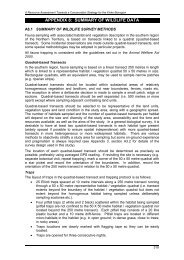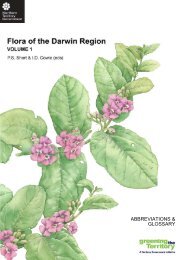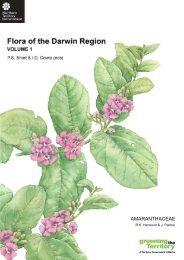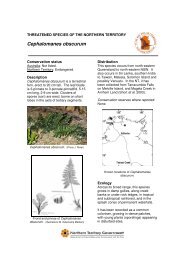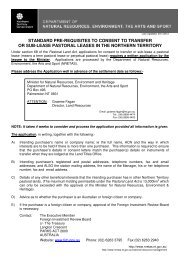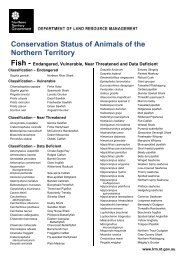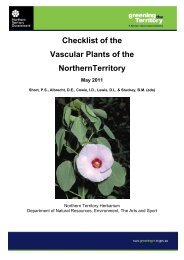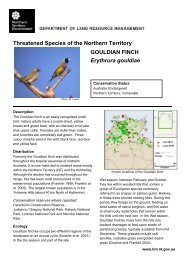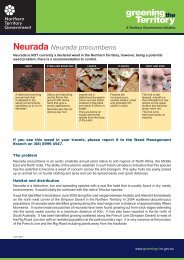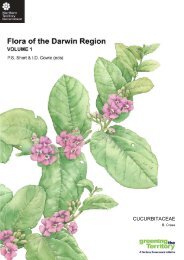DILLENIACEAE - Department of Land Resource Management ...
DILLENIACEAE - Department of Land Resource Management ...
DILLENIACEAE - Department of Land Resource Management ...
You also want an ePaper? Increase the reach of your titles
YUMPU automatically turns print PDFs into web optimized ePapers that Google loves.
Fig. 5 (Fox 2502; Wightman 1276).<br />
Endemic to the N.T. Associated with the western<br />
Arnhem <strong>Land</strong> Plateau, where it is recorded from<br />
the catchments <strong>of</strong> the Katherine, South Alligator,<br />
East Alligator and Liverpool rivers. Grows in<br />
crevices and clefts in sandstone, in open forest on<br />
sandstone scree.<br />
H. sphenandra (F. Muell. & Tate) J.W. Horn<br />
Pachynema sphenandrum F. Muell. & Tate<br />
Subshrub to 0.25 m high. Stems much-branched<br />
from the base, terete to subterete. Leaves not<br />
persisting (N.T.), widely spathulate or obovate,<br />
20–40 mm long, 8–25 mm wide, glabrous, the<br />
midrib very slightly impressed on the upper<br />
surface and raised on the lower surface, the<br />
primary veins obscure to raised, obtuse, the<br />
margin serrate to incised-serrate in the distal half,<br />
entire below, attenuate, decurrent to the petiole<br />
base. Peduncle not clearly differentiated, flowers<br />
terminating lateral, bracteate branchlets 0–14 cm<br />
long. Sepals unequal; outer two ovate, 4 mm long;<br />
inner three orbicular, 4 mm long, sometimes<br />
ciliate. Petals elliptic, 5 mm long, cerise, usually<br />
<strong>DILLENIACEAE</strong> 15<br />
REFERENCES<br />
persistent. Corona an irregularly lobed, membranous,<br />
persistent sheath encircling the stamens;<br />
2 mm long. Stamens and staminodes in 2 series, outer<br />
series with 7 stamens, inner series with 2 smaller<br />
stamens or with 2 staminodes with vestigial<br />
thecae. Stamens c. 1.5 mm long; filament ovate,<br />
angular, the apex sloping towards the carpels, very<br />
widely obovate (5:6) in section, smooth to<br />
subpapillate; anther not differentiated, the thecae<br />
obscure, embedded in the filament, c. 0.3 mm<br />
long, dehiscence introrse with the slit short and<br />
porate. Carpels 2, 1.5–1.6 mm long, the style<br />
0.6 mm long. Seeds spheroidal, 3–4 mm diam.<br />
Flowering & fruiting: Dec.–June.<br />
Fig. 5 (Dunlop 6042; Menkhorst 265); Pl. 14<br />
(unvouchered).<br />
Northern Australia (W.A., N.T.). In the N.T.<br />
found on the Tiwi Islands south to the Bradshaw<br />
Field Training Area and eastwards to Groote<br />
Eylandt. Recorded as occurring on granitic debris;<br />
in eucalypt woodland and open forest on welldrained<br />
lateritic, granitic or brown sandy soils, and<br />
whitish sandy soils on sandstone.<br />
Craven, L.A. & Dunlop, C.R. (1992). A taxonomic revision <strong>of</strong> Pachynema (Dilleniaceae). Australian<br />
Systematic Botany 5: 477–500.<br />
Cronquist, A. (1981). An Integrated System <strong>of</strong> Classification <strong>of</strong> Flowering Plants. (Columbia University Press:<br />
New York).<br />
Hoogland, R.D. (1949). Dilleniaceae. In Steenis, C.G.G.J. van (ed.), Flora malesiana. (P. Noordh<strong>of</strong>f Ltd).<br />
Ser. I, vol. 4, pp. 141–174.<br />
Hoogland, R.D. (1952). A revision <strong>of</strong> the genus Dillenia. Blumea 7: 1–306.<br />
Hoogland, R.D. (1983). Notes on some Hibbertia species. Australian Systematic Botany Society 34: 3–4.<br />
Horn, J.W. (2007). Dilleniaceae. In Kubitzki, K. (ed), The Families and Genera <strong>of</strong> Vascular Plants. (Springer-<br />
Verlag: Berlin). Vol. 9, pp. 133–154.<br />
Horn, J.W. (2009). Phylogenetics <strong>of</strong> Dilleniaceae using sequence data from four plastid loci (rbcL, rps4,<br />
rpl16 intron). International Journal <strong>of</strong> Plant Sciences 170: 794–813.<br />
Hyland, B.P.M., Whiffin, T., Christophel, D.C., Gray, B. & Elick, R.W. (2002). Australian Tropical<br />
Rainforest Plants. (CDROM). (CSIRO Publishing: Melbourne).<br />
Kubitzki, K. (2004). Dilleniaceae. In Smith, N., Mori, S.A., Henderson, A., Stevenson, D.W. & Heald,<br />
S.V. (eds), Flowering Plants <strong>of</strong> the Neotropics. (Princeton University Press: Princeton, New Jersey).<br />
pp. 128–130.<br />
Toelken, H.R. (2010). Notes on Hibbertia (Dilleniaceae) 5. H. melhanioides and H. tomentosa groups from<br />
tropical Australia. Journal <strong>of</strong> the Adelaide Botanic Gardens 23: 1–117.<br />
Wheeler, J.R. (1992). Dilleniaceae. In Wheeler, J.R. (ed.), Flora <strong>of</strong> the Kimberley Region. (Dept Conservation<br />
& <strong>Land</strong> <strong>Management</strong>: Como). pp. 151–155.<br />
FDRV1 March 2011


